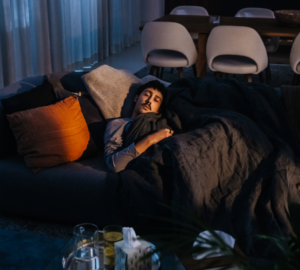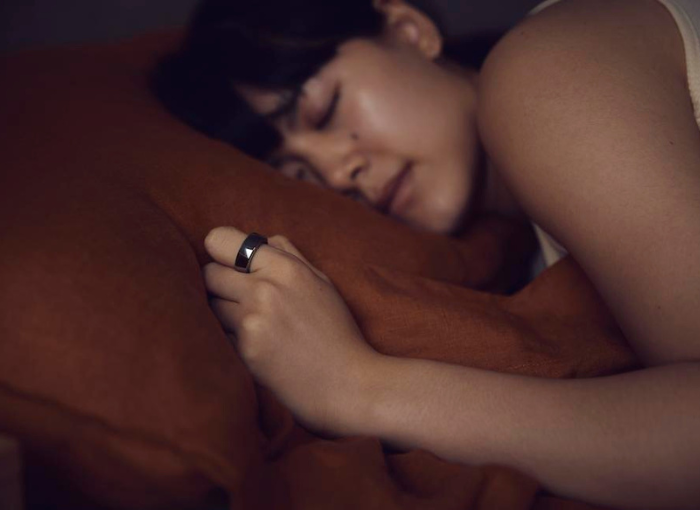- Sleep latency, the time it takes to transition from wakefulness to sleep, offers a measure of sleep quality.
- Using Oura, you can monitor your sleep latency (the time it takes you to fall asleep) and learn what helps to improve the quality of your sleep.
- Some techniques to reduce sleep latency include the military method, guided imagery, and 4-7-8 breathing.
Struggling to fall asleep, also known as sleep onset insomnia, is one of the most common causes of sleep deprivation. To no one’s surprise, sleep deprivation can negatively affect your daily activities and impair cognitive function.
Sleep latency, or a measure of how long it takes you to fall asleep, offers an accurate way to determine how well you’re meeting your sleep needs. In other words, it’s the amount of time it takes to go from being fully awake to sleeping.
| Member Tip: In the Oura App, sleep latency is one of the contributors that make up your Sleep Score. This contributor evaluates the amount of time it takes for you to fall asleep, against recommended sleep latency time, helping you determine the overall quality of your sleep. |
RELATED: Sleep Debt: Is It Possible to Catch Up on Lost Sleep?
What Is a Good Sleep Latency?
On average, a healthy person has a sleep latency between 10 and 20 minutes. While sleep latencies vary by person, a sleep latency of more than 20 minutes can be a sign of insomnia. Longer sleep latency is linked to poor sleep quality, which can lead to several problems, including:
- Excessive daytime sleepiness: When you struggle to fall asleep quickly, you may not get enough deep sleep, leading to daytime sleepiness and fatigue. This can impact your ability to concentrate, focus, and perform daily tasks effectively.
- Reduced cognitive function: The lack of enough quality sleep is associated with reduced cognitive abilities, including memory problems and difficulty in processing information.
- Cardiovascular diseases: Poor sleep quality and sleep deprivation can increase the risk of cardiovascular diseases such as heart disease and stroke.
- Reproductive health problems: Studies have shown that individuals with low sleep quality may experience disruptions in hormone levels, which can adversely affect reproductive health in both men and women.
READ MORE: The Link Between Sleep and Fertility in Women
Is Falling Asleep Fast a Good Thing?
Falling asleep too quickly isn’t always a good thing. In fact, research suggests that a sleep latency of less than eight minutes may indicate severe sleepiness caused by sleep deprivation.
A consistently short sleep latency could also be a sign of an underlying sleep disorder like narcolepsy, restless leg syndrome, or sleep apnea. These sleep disorders can lead to excessive sleepiness, causing you to fall asleep too quickly at night as the body tries to make up for the sleep debt.
While it can’t be used to diagnose medical conditions, Oura can provide helpful insights into how certain conditions like sleep apnea and restless leg syndrome may be affecting how well you sleep. For example, Oura members with restless leg syndrome can use the Nighttime Movement feature to determine if excess movement during the night is affecting their quality of sleep.
Oura members can also monitor their blood oxygen levels and make sure they’re in a healthy range, as well as see if breathing disturbances could be disrupting their shuteye.
Conditions such as narcolepsy, which causes drowsiness during the day, can also cause you to fall asleep too quickly at night, as can idiopathic hypersomnia, a condition that causes excessive sleepiness with no known cause. Both conditions result in very short sleep latency because you’re not getting enough restorative sleep during the night.
| Member Tip: You can use Oura to monitor your sleep latency and make sure it’s not too short or too long over a period of time. If you consistently experience a long or short sleep latency, and it affects how you feel during the day, consult a healthcare professional. |
How To Fall Asleep Fast
If you’re taking a long time to fall asleep and it’s impacting how you feel the next day, it might be time to try some interventions to help you fall asleep more quickly.
First and foremost, take a closer look at your sleep hygiene — i.e., your environment, behaviors, and habits as you get ready to sleep. Improving your sleep hygiene can be as simple as removing all sources of light in your bedroom, drinking soothing tea, or playing some calming background noise as you prepare for sleep.
To set the stage for good sleep, you’ll also want to keep your bedroom as cool as possible and try a warm shower or bath before bed to signal to your body it’s time to wind down. Other tweaks to your sleep hygiene include avoiding caffeine, alcohol, and heavy meals before bed.
RELATED: How Caffeine Affects Your Sleep
If you clean up your sleep hygiene and you’re still lying awake at night, it might be time to try some different interventions.
4 Techniques to Help You Fall Asleep Fast
1. Guided Imagery
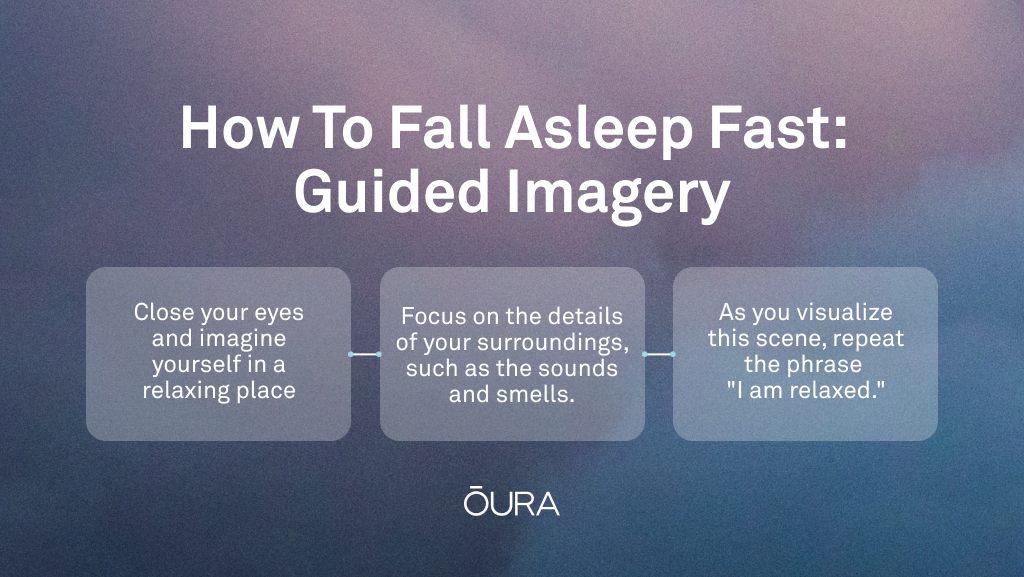
Guided imagery uses your imagination to create a calming and peaceful mental scene. The key is to let the imagery divert your mind from any racing thoughts or concerns and encourage relaxation. In one study, researchers discovered that people who engaged in ‘imagery distraction” fell asleep faster than those who didn’t.
To practice guided imagery:
- Find a comfortable position in bed and close your eyes.
- Imagine yourself in a relaxing place, such as a beach or a forest with a waterfall.
- Focus on the details of your surroundings, such as the sounds, smells, and textures.
- As you visualize this scene, repeat the phrase “I am relaxed” to yourself.
Once you’re relaxed, you should be able to fall asleep in a short time.
Here’s a short snippet of a visualization-based guided meditation you can access through the Oura App under Explore content.
2. Progressive Muscle Relaxation
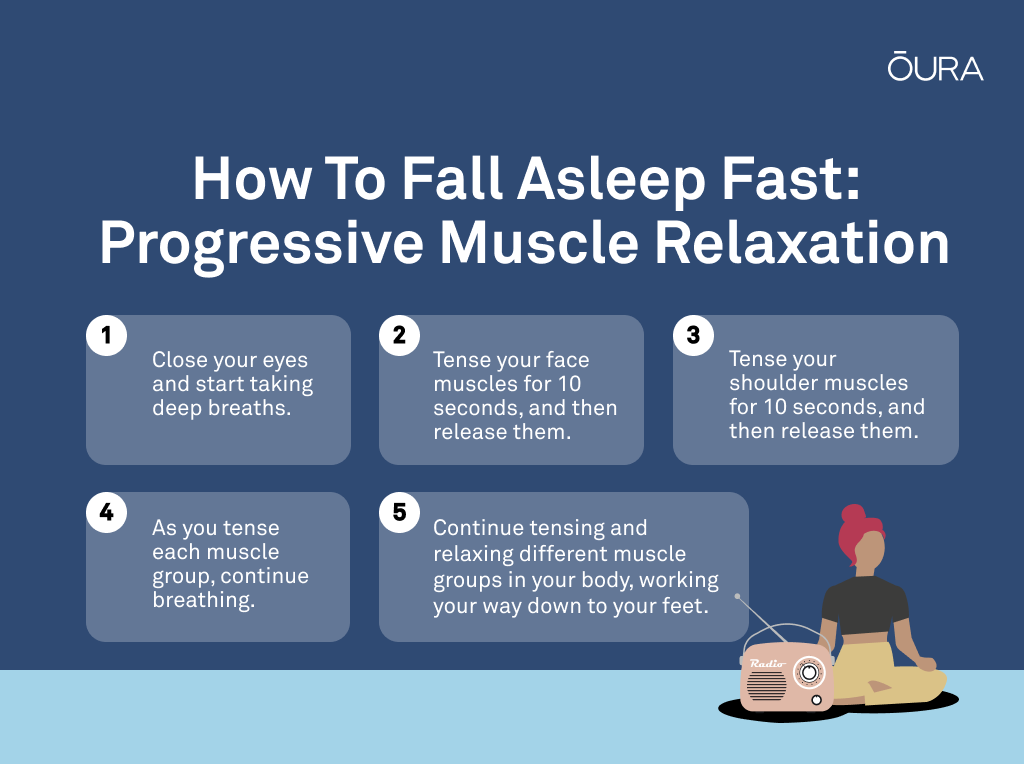
First introduced in the 1930s, progressive muscle relaxation is a proven method to help relax the body and mind. One study found that people experiencing anxiety slept better after practicing three 20- to 30-minute sessions of this technique.
To practice progressive muscle relaxation:
- Lie in bed, close your eyes, and start taking deep breaths.
- Start by tensing your face muscles for 10 seconds, and then release them.
- Next, tense your shoulder muscles for 10 seconds, and then release them.
- Continue tensing and relaxing different muscle groups in your body, working your way down to your feet.
As you tense each muscle group, continue breathing, but make sure to leave out any muscles that are painful.
Here is a short snippet of a progressive, full-body relaxation meditation that you can access via Explore in the Oura App.
RELATED: 10 Simple Breathing Exercises for Sleep and Relaxation
3. 4-7-8 Breathing Method
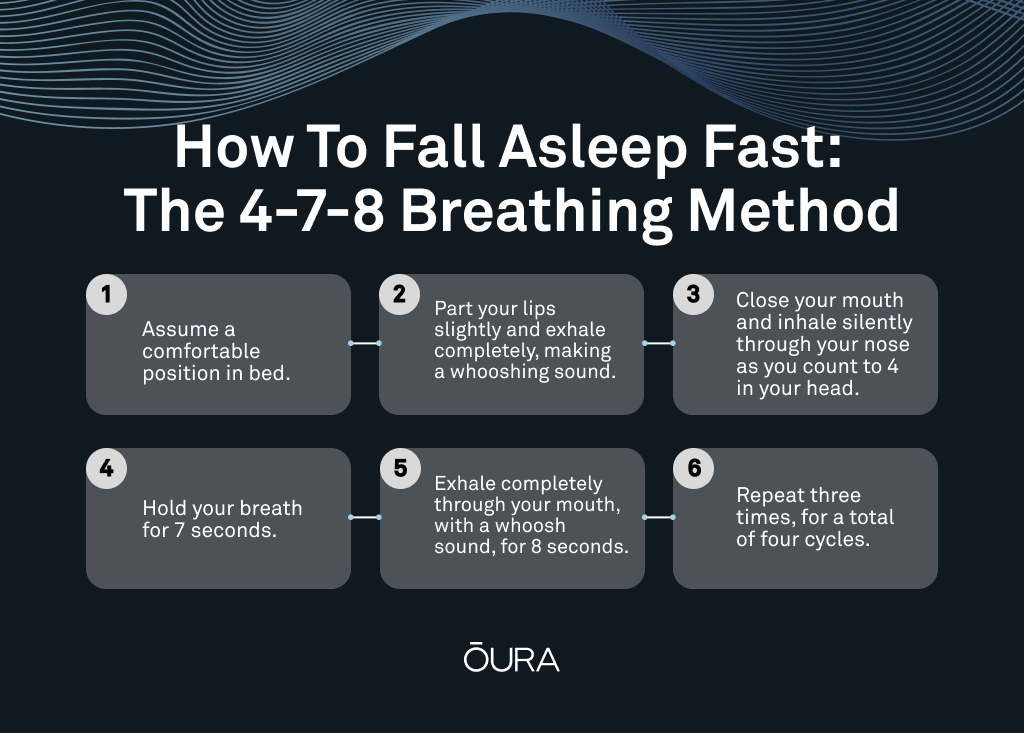
The 4-7-8 breathing technique is a simple yet effective way to calm your mind and body before bed.
A similar technique is called box breathing, in which you inhale, hold, and exhale for the same amount of time (for example, four-four-four counts).
| Member Tip: Oura members can access similar breathing exercises to these in the Explore content of the Oura App. After each session, members receive a Wellness Session Biofeedback report detailing how their body responded to the session. |
To try this method:
- Find a comfortable position in bed and relax.
- Part your lips slightly and exhale completely through your mouth, making a whooshing sound.
- Close your mouth and inhale silently through your nose as you count 4 seconds in your head.
- Hold your breath for 7 seconds.
- Exhale completely through your mouth, with a whoosh sound, for 8 seconds.
- This is one breath cycle. Repeat the cycle three more times for a total of four cycles.
If sleep comes to you earlier, you don’t have to complete all cycles. Also, if you have a respiratory condition, such as asthma, it’s a good idea to speak to your doctor before beginning the breathing exercise as it may worsen your symptoms.
READ MORE: 5 Simple Breathing Techniques for a Good Night’s Sleep
4. The Military Method
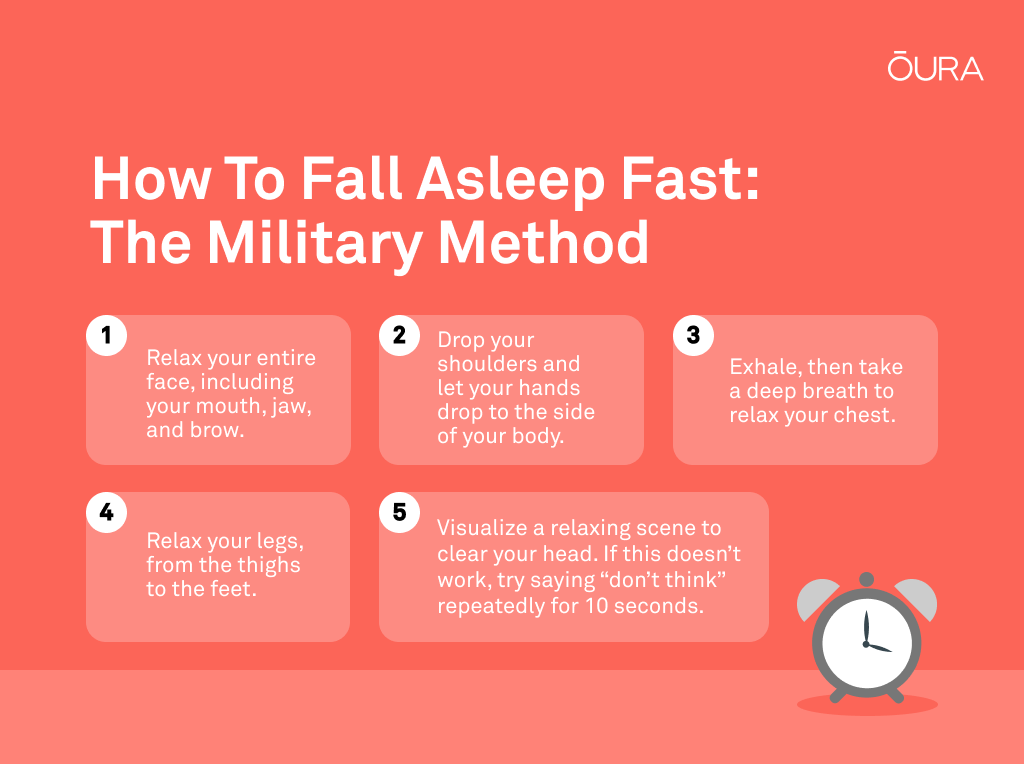
This technique, known as the “military method,” was developed during World War II to help stressed and sleep-deprived Navy pilots fall asleep in mere minutes. The technique includes the following steps:
- Assume a comfortable position in bed and relax your entire face, including the muscles in your mouth, jaw, and brow.
- Drop your shoulders as low as they’ll go to release any tension and bring your hands to the side of your body.
- Exhale, then take deep breaths to relax your chest, followed by relaxing your legs from thighs to feet.
- As you relax your body, visualize a relaxing scene to put your mind at ease. If visualization is difficult, repeat a simple phrase like “don’t think” in your mind, to clear your head and fall asleep more easily.
Some Ways to Fall Asleep Fast That Don’t Work
In popular culture, there are many often-cited tips and tricks to help you fall asleep fast that don’t actually have a lot of science behind them. To name a few:
- Counting sheep: Although counting sheep is a popular notion, its effectiveness varies. For example, it may keep your mind engaged, hindering relaxation rather than promoting it.
- Drinking alcohol: While some people turn to alcohol to fall asleep faster, its impact is deceiving. Alcohol may induce drowsiness initially, but it disrupts sleep patterns and undermines overall sleep quality. Oura members can use Tags to see how alcohol impacts their sleep quality.
- Sleeping pills: Occasional medication might be helpful, or even necessary, to help you fall asleep, but an overreliance on sleeping pills is an unsustainable approach to long latency. It can lead to dependency or other health complications, such as drowsiness, dizziness, and headaches. Plus, sleeping pills can mask the underlying cause of insomnia, making it difficult to treat the problem.
- Watching TV: Some people believe that watching TV, especially TV static, can help them wind down and fall asleep faster. Perhaps this is because TV static is likened to white noise, which may improve sleep. However, the blue light emitted by screens can suppress the production of melatonin, a hormone that regulates sleep-wake cycles, making it harder to fall asleep. Instead of watching TV static, try listening to calming sounds that promote sleep.
- Eating a heavy meal before bed: Large, heavy meals may induce sleepiness. Nonetheless, research has shown that eating a heavy meal close to bedtime can lead to discomfort and indigestion, and this can disrupt your sleep. If you have to eat before bed — for example, if you have low blood sugar — opt for a small, light snack.
READ MORE: 8 Foods and Drinks For Better Sleep (And 4 To Avoid!)



